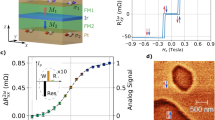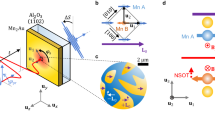Abstract
Spintronics based on ferromagnets has enabled the development of microwave oscillators and diodes. To achieve even faster operation, antiferromagnets hold great promise despite their challenging manipulation. So far, controlling antiferromagnetic order with microwave currents remains elusive. Here we induce the coherent rotation of antiferromagnetic spins in a Weyl antiferromagnet W/Mn3Sn epitaxial bilayer by DC spin–orbit torque. We show the efficient coupling of this spin rotation with microwave current. The coupled dynamics produce a DC anomalous Hall voltage through rectification, which we coin the antiferromagnetic spin-torque diode effect. Unlike in ferromagnetic systems, the output voltage shows minimal dependence on frequency because of the stabilization of the precession cone angle by exchange interactions. Between 10 GHz and 30 GHz, the output voltage decreases by only 10%. Numerical simulations further reveal that the rectification signals arise from the fast frequency modulation of chiral spin rotation by microwave spin–orbit torque. These results may help the development of high-speed microwave devices for next-generation telecommunication applications.
This is a preview of subscription content, access via your institution
Access options
Access Nature and 54 other Nature Portfolio journals
Get Nature+, our best-value online-access subscription
$32.99 / 30 days
cancel any time
Subscribe to this journal
Receive 12 print issues and online access
$259.00 per year
only $21.58 per issue
Buy this article
- Purchase on SpringerLink
- Instant access to full article PDF
Prices may be subject to local taxes which are calculated during checkout




Similar content being viewed by others
Data availability
The data of this work are included in the published article and its Supplementary Information. Additional raw data are available from the corresponding authors upon request.
Code availability
The calculation and simulation codes are available from the corresponding authors upon reasonable request.
References
Tsoi, M. et al. Excitation of a magnetic multilayer by an electric current. Phys. Rev. Lett. 80, 4281 (1998).
Katine, J. A., Albert, F. J., Buhrman, R. A., Myers, E. B. & Ralph, D. C. Current-driven magnetization reversal and spin-wave excitations in Co/Cu/Co pillars. Phys. Rev. Lett. 84, 3149 (2000).
Kiselev, S. I. et al. Microwave oscillations of a nanomagnet driven by a spin-polarized current. Nature 425, 380 (2003).
Rippard, W. H., Pufall, M. R., Kaka, S., Russek, S. E. & Silva, T. J. Direct-current induced dynamics in Co90Fe10/Ni80Fe20 point contacts. Phys. Rev. Lett. 92, 027201 (2004).
Chen, T. et al. Spin-torque and spin-Hall nano-oscillators. Proc. IEEE 104, 1919 (2016).
Tulapurkar, A. A. et al. Spin-torque diode effect in magnetic tunnel junctions. Nature 438, 339 (2005).
Sankey, J. C. et al. Spin-transfer-driven ferromagnetic resonance of individual nanomagnets. Phys. Rev. Lett. 96, 227601 (2006).
Miwa, S. et al. Highly sensitive nanoscale spin-torque diode. Nat. Mater. 13, 50 (2013).
Locatelli, N., Cros, V. & Grollier, J. Spin-torque building blocks. Nat. Mater. 13, 11 (2013).
Finocchio, G. et al. Perspectives on spintronic diodes. Appl. Phys. Lett. 118, 160502 (2021).
Liu, L., Moriyama, T., Ralph, D. C. & Buhrman, R. A. Spin-torque ferromagnetic resonance induced by the spin Hall effect. Phys. Rev. Lett. 106, 036601 (2011).
Bonetti, S., Muduli, P., Mancoff, F. & Åkerman, J. Spin torque oscillator frequency versus magnetic field angle: the prospect of operation beyond 65 GHz. Appl. Phys. Lett. 94, 102507 (2009).
Houssameddine, D. et al. Spin-torque oscillator using a perpendicular polarizer and a planar free layer. Nat. Mater. 6, 447 (2007).
Gomonay, H. V. & Loktev, V. M. Spin transfer and current-induced switching in antiferromagnets. Phys. Rev. B 81, 144427 (2010).
Khymyn, R., Lisenkov, I., Tiberkevich, V., Ivanov, B. A. & Slavin, A. Antiferromagnetic THz-frequency Josephson-like oscillator driven by spin current. Sci. Rep. 7, 43705 (2017).
Sulymenko, O. R. et al. Terahertz-frequency spin Hall auto-oscillator based on a canted antiferromagnet. Phys. Rev. Appl. 8, 064007 (2017).
Chen, H., Niu, Q. & MacDonald, A. H. Anomalous Hall effect arising from noncollinear antiferromagnetism. Phys. Rev. Lett. 112, 017205 (2014).
Nakatsuji, S., Kiyohara, N. & Higo, T. Large anomalous Hall effect in a non-collinear antiferromagnet at room temperature. Nature 527, 212 (2015).
Park, B. G. et al. A spin-valve-like magnetoresistance of an antiferromagnet-based tunnel junction. Nat. Mater. 10, 347 (2011).
Marti, X. et al. Room-temperature antiferromagnetic memory resistor. Nat. Mater. 13, 367 (2014).
Chen, X. et al. Octupole-driven magnetoresistance in an antiferromagnetic tunnel junction. Nature 613, 490 (2023).
Qin, P. et al. Room-temperature magnetoresistance in an all-antiferromagnetic tunnel junction. Nature 613, 485 (2023).
Wadley, P. et al. Electrical switching of an antiferromagnet. Science 351, 587 (2016).
Tsai, H. et al. Electrical manipulation of a topological antiferromagnetic state. Nature 580, 608 (2020).
Li, J. et al. Spin current from sub-terahertz-generated antiferromagnetic magnons. Nature 578, 70 (2020).
Vaidya, P. et al. Subterahertz spin pumping from an insulating antiferromagnet. Science 368, 160 (2020).
Safin, A. et al. Electrically tunable detector of THz-frequency signals based on an antiferromagnet. Appl. Phys. Lett. 117, 222411 (2020).
Yang, D. et al. Electrically tunable terahertz resonance in antiferromagnetic NiO/Pt heterostructures. Phys. Rev. Appl. 20, 014023 (2023).
Zhou, Y. et al. Spin-torque-driven antiferromagnetic resonance. Sci. Adv. 10, eadk7935 (2024).
Jungwirth, T., Marti, X., Wadley, P. & Wunderlich, J. Antiferromagnetic spintronics. Nat. Nanotechnol. 11, 231 (2016).
Baltz, V. et al. Antiferromagnetic spintronics. Rev. Mod. Phys. 90, 015005 (2018).
Šmejkal, L., Mokrousov, Y., Yan, B. & MacDonald, A. H. Topological antiferromagnetic spintronics. Nat. Phys. 14, 242 (2018).
Šmejkal, L., MacDonald, A. H., Sinova, J., Nakatsuji, S. & Jungwirth, T. Anomalous Hall antiferromagnets. Nat. Rev. Mater. 7, 482 (2022).
Nakatsuji, S. & Arita, R. Topological magnets: functions based on Berry phase and multipoles. Annu. Rev. Condens. Matter Phys. 13, 119 (2022).
Han, J., Cheng, R., Liu, L., Ohno, H. & Fukami, S. Coherent antiferromagnetic spintronics. Nat. Mater. 22, 684 (2023).
Takeuchi, Y. et al. Chiral-spin rotation of non-collinear antiferromagnet by spin–orbit torque. Nat. Mater. 20, 1364 (2021).
Torrejon, J. et al. Neuromorphic computing with nanoscale spintronic oscillators. Nature 547, 428 (2017).
Grollier, J. et al. Neuromorphic spintronics. Nat. Electron. 3, 360 (2020).
Suzuki, M.-T., Koretsune, T., Ochi, M. & Arita, R. Cluster multipole theory for anomalous Hall effect in antiferromagnets. Phys. Rev. B 95, 094406 (2017).
Kuroda, K. et al. Evidence for magnetic Weyl fermions in a correlated metal. Nat. Mater. 16, 1090 (2017).
Yang, H. et al. Topological Weyl semimetals in the chiral antiferromagnetic materials Mn3Ge and Mn3Sn. New J. Phys. 19, 015008 (2017).
Zhang, Y. et al. Strong anisotropic anomalous Hall effect and spin Hall effect in the chiral antiferromagnetic compounds Mn3X (X = Ge, Sn, Ga, Ir, Rh, and Pt). Phys. Rev. B 95, 075128 (2017).
Ikhlas, M. et al. Large anomalous Nernst effect at room temperature in a chiral antiferromagnet. Nat. Phys. 13, 1085 (2017).
Li, X. et al. Anomalous Nernst and Righi-Leduc effects in Mn3Sn: Berry curvature and entropy flow. Phys. Rev. Lett. 119, 056601 (2017).
Higo, T. et al. Perpendicular full switching of chiral antiferromagnetic order by current. Nature 607, 474 (2022).
Pal, B. et al. Setting of the magnetic structure of chiral kagome antiferromagnets by a seeded spin–orbit torque. Sci. Adv. 8, eabo5930 (2022).
Yan, G. Q. et al. Quantum sensing and imaging of spin–orbit-torque-driven spin dynamics in the non-collinear antiferromagnet Mn3Sn. Adv. Mater. 34, 2200327 (2022).
Sakamoto, S. et al. Observation of spontaneous x-ray magnetic circular dichroism in a chiral antiferromagnet. Phys. Rev. B 104, 134431 (2021).
Yoon, J.-Y. et al. Handedness anomaly in a non-collinear antiferromagnet under spin–orbit torque. Nat. Mater. 22, 1106 (2023).
Krishnaswamy, G. K. et al. Time-dependent multistate switching of topological antiferromagnetic order in Mn3Sn. Phys. Rev. Appl. 18, 024064 (2022).
Rippard, W. H. et al. Injection locking and phase control of spin transfer nano-oscillators. Phys. Rev. Lett. 95, 067203 (2005).
Georges, B. et al. Coupling efficiency for phase locking of a spin transfer nano-oscillator to a microwave current. Phys. Rev. Lett. 101, 017201 (2008).
Fang, B. et al. Giant spin-torque diode sensitivity in the absence of bias magnetic field. Nat. Commun. 7, 11259 (2016).
You, Y. et al. Anomalous Hall effect–like behavior with in-plane magnetic field in noncollinear antiferromagnetic Mn3Sn films. Adv. Electron. Mater. 5, 1800818 (2019).
Yoon, J. et al. Crystal orientation and anomalous Hall effect of sputter-deposited non-collinear antiferromagnetic Mn3Sn thin films. Appl. Phys. Express 13, 013001 (2019).
Nomoto, T. & Arita, R. Cluster multipole dynamics in noncollinear antiferromagnets. Phys. Rev. Res. 2, 012045 (2020).
Acknowledgements
We thank K. Kondou of RIKEN for discussion. X-ray diffraction measurements, chemical composition analysis and electrode deposition were performed at the X-ray laboratory, the electron microscope section and Q-NanoLab of the Institute for Solid State Physics, The University of Tokyo, respectively. The synchrotron radiation experiments were performed at the BL25SU of SPring-8 with the approval of the Japan Synchrotron Radiation Research Institute (JASRI) (proposal no. 2022A1072). This work was supported by JSPS KAKENHI (nos. JP19H05825, JP21H04437, JP22H00290, 22H04964, 23H01833 and 24H02234), JST CREST (JPMJCR18T3), JST-Mirai Program (JPMJMI20A1), MEXT Initiative to Establish Next-Generation Novel Integrated Circuit Centers (X-NICS) (no. JPJ011438), JST-PRESTO (no. JPMJPR20L7), JST-ASPIRE (no. JPMJAP2317) and Spintronics Research Network of Japan (Spin-RNJ). The Institute for Quantum Matter, an Energy Frontier Research Center, was funded by DOE, Office of Science, Basic Energy Sciences, under award no. DE-SC0024469.
Author information
Authors and Affiliations
Contributions
S.S. and S.M. conceived and designed the experiments. S.S. made the devices and performed electrical measurements. S.S., T.H., H.K., M.S. and D.N.-H. developed epitaxial Mn3Sn thin films, and Y.H. and K.Y. fabricated polycrystalline Mn3Sn thin films. S.S. performed microwave experiments with help of T.Y., S.T. and T. Nozaki. S.S., Y.K. and T. Nakamura conducted X-ray magnetic circular dichroism measurements. S.S., T. Nomoto and R.A. performed numerical calculations. S.S., S.N. and S.M. wrote the paper with inputs from all the authors.
Corresponding authors
Ethics declarations
Competing interests
The authors declare no competing interests.
Peer review
Peer review information
Nature Nanotechnology thanks Enrique del Barco, Zhongming Zeng and the other, anonymous, reviewer(s) for their contribution to the peer review of this work.
Additional information
Publisher’s note Springer Nature remains neutral with regard to jurisdictional claims in published maps and institutional affiliations.
Supplementary information
Supplementary Information
Supplementary Figs. 1–12 and discussion.
Rights and permissions
Springer Nature or its licensor (e.g. a society or other partner) holds exclusive rights to this article under a publishing agreement with the author(s) or other rightsholder(s); author self-archiving of the accepted manuscript version of this article is solely governed by the terms of such publishing agreement and applicable law.
About this article
Cite this article
Sakamoto, S., Nomoto, T., Higo, T. et al. Antiferromagnetic spin-torque diode effect in a kagome Weyl semimetal. Nat. Nanotechnol. 20, 216–221 (2025). https://doi.org/10.1038/s41565-024-01820-0
Received:
Accepted:
Published:
Issue date:
DOI: https://doi.org/10.1038/s41565-024-01820-0
This article is cited by
-
Empowering spintronics with antiferromagnetic diodes
Nature Nanotechnology (2025)



